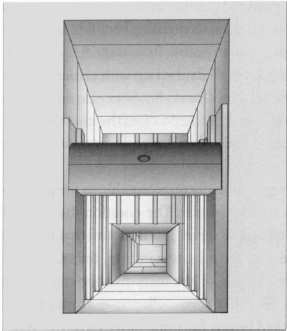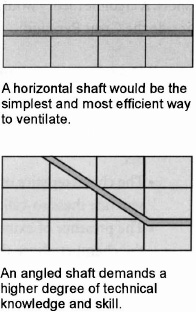The Giza Power Plant (8 page)

Another point that satisfies this theory is an attempt to rectify, to some extent, some of the damage in the King's Chamber. Again Petrie related some pertinent facts concerning the ancient guardians' inspection: "The roofing beams are not of 'polished granite,' as they have been described; on the contrary, they have rough-dressed surfaces, very fair and true so far as they go, but without any pretence to polish. Round the S.E. corner, for about five feet on either side, the joint is all daubed up with cement laid on by fingers. The crack across the Eastern roof-beam has been also daubed with cement, looking therefore, as if it had cracked
before
the chamber was finished. At the S.W. corner, plaster is freely spread over the granite, covering about a square foot
altogether."
17
The cracks were evidently unacceptable to the guardians, and required the addition of a layer of plaster. The question that arises is, what purpose does a thin layer of plaster serve? It is doubtful that it would lend any structural improvement to the granite complex, for what could a thin layer of cement do to prevent one of the forty-five-or seventy-ton granite beams above the King's Chamber from collapsing? Would the cement have been added to the cracked beams for some other purpose? Whatever the answer, it was evidently important enough that the Great Pyramid was entered, at
the expense of a great deal of time and trouble, to make repairs.
If we could talk with those who entered the Great Pyramid to make these repairs, what would they tell us regarding the nature of the disturbance in the King's Chamber? And how would they explain the fact that the chamber had expanded? Would they confirm the earthquake theory? Or would they gently inform us that if an earthquake had indeed shaken the chamber, it would, in all probability, have collapsed? Furthermore, how would they explain their even knowing that such a disturbance had affected the well-insulated King's Chamber? Could they convince us that the minute variation from true level found in the base of the pyramid justified their effort in inspecting the small chamber at its heart? Let us face factsâthe guardians would have a lot of explaining to do.
There are more questions raised by the King's Chamber. At first glance, it appears to be just a room made from red granite. As we look closer, though, it poses more mysteries than the rest of the chambers and passages of the Great Pyramid combined. While poking around the pyramid, John Greaves partially uncovered one of these mysteries.
Greaves was puzzled by the many features of the Great Pyramid that
seemed to be inconsistent with any logical design for a tomb. The Grand Gallery was especially disturbing to this English mathematician and astronomer, whose mind was schooled in the orderliness of nature. He questioned that the Grand Gallery was built to serve as a stairway leading to the King's Chamber, for he had trouble making his way to the top. Its size, the corbeled walls, and the fact that it was built on such a steep angle did not indicate to him that it could have been used as a chamber either. Besides, in order to get to the Grand Gallery, he had to double over and squeeze his way through the Ascending Passage in much the same way as Al Mamun and his men did before him.

F
IGURE
8.
Antechamber
At the end of the Grand Gallery, stooping to enter the passage that led to the Antechamber, Greaves was baffled by the "portcullis" entrance, and he wondered why the walls, floor, and ceiling suddenly changed from limestone to granite. He could not even begin to fathom the complex Antechamber (see Figure 8).
The passage leading from the Antechamber to the King's Chamber is actually smaller than the sarcophagus, or coffer, that sits within the chamber, so that would had to have been installed at the time the pyramid was under construction and before the ceiling beams over the King's Chamber were put in place. Regarding the King's Chamber, Greaves wondered why a single chamber, which housed a solitary, empty coffer, needed the protection of the tremendous amount of masonry that surrounded it. He questioned why a structure as huge as the Great Pyramid was necessary for a single burial.
What is more, in the King's Chamber, Greaves observed small openings in both the north and south walls. They were not given much attention at first, and were thought to be receptacles for candles or lamps. However, after Howard-Vyse's assistant, Perring, was almost decapitated when a stone shot out of one opening and barely missed his head, it became clear that the "lamp receptacles" were actually the lower ends of shafts that ran through the body of the pyramid to the outside. The stone that almost injured Perring had evidently cleared some blockage in the shaft while it was making its way to the inner chamber, for immediately afterward a rush of cool air entered the chamber. It is reported that with the clearing of the shafts to the King's Chamber) the chamber maintained a constant temperature of 68°
Fahrenheit, no matter what the weather or temperature was outside. This temperature is no longer constant because the tourists who go through the Great Pyramid nearly every day generate body heat and moisture. I have been left hot and sweaty each time I crawled through the Ascending Passage or climbed the Great Gallery. The problems associated with this elevation of temperature and humidity in the King's Chamber prompted the Egyptians to contract with Rudolph Gantenbrink, a German engineer, to install fans in the Northern and Southern Shafts to improve the circulation of air (see Figure 9).

F
IGURE
9.
Southern Shaft in the King's Chamber
What purpose do these shafts serve? Imagine the difficulty of including these shafts in the construction of the pyramid. If they were intended to supply the King's Chamber with air, a simpler method of construction could have been used, for instance, following a horizontal path along a course of masonry to the outside. This alternative method probably would have resulted in greater airflow as well. Because of these considerations, and the fact that the dead do not breathe, Egyptologists believe that the shafts were not intended to ventilate the chamber at all, but were constructed purely for symbolic or cultic reasons.
In addition, there are significant technical problems associated with
constructing the pyramid with the shafts on an incline. The limestone blocks that form the shafts on the north side would have needed precise compound angles on their adjoining faces as they turn to avoid the Grand Gallery (see Figure 10).

F
IGURE
10.
Horizontal Airshaft vs. Angled Airshaft
When I was inside the Great Pyramid in 1995, I noticed an iron gate covering an opening in the passageway between the Grand Gallery and the Antechamber. The iron gate was unlocked, so I took the opportunity to climb into a small tunnel with my flashlight to see where it went. When I reached the end, I found myself looking at what remains of the Northern Shaft, and I was able to witness the quality of fit between those limestone blocks. As I swept the shaft with my light, I could see the fan that Gantenbrink had installed to ventilate the chamber. The shafts were exposed on the bottom side, and I was able to see that they were cleanly cut, with square, sharp inside corners. Knowing of the precision built into the rest of the pyramid, and into other ancient artifacts I had seen in Egypt, I was not surprised by the quality of workmanshipâthough having worked with compound angles where features of a component have to fit together without any mismatch, I could not help but be impressed. This kind of precision is not coincidental, and the builders would not have invested the resources necessary to cut and construct this feature if there was not a real need for such precision. That likelihood in itself contradicts the symbolic or cultic reasons Egyptologists ascribe to the shafts. And besides, there are simpler ways of illustrating symbolism and cultism, such as the reliefs and paintings that the ancient Egyptians created with great skill.
Any theory about the Great Pyramid should both satisfy the demands of logic and provide answers for all the relevant discoveries that have promoted so much perplexity in the past. As we have seen in this chapter, current theories regarding the function and construction of the pyramid fall
short. A credible theory would have to explain the following conditions found inside the Great Pyramid:
- The selection of granite as the building material for the King's Chamber. It is evident that in choosing granite, the builders took upon themselves an extremely difficult task.
- The presence of four superfluous chambers above the King's Chamber.
- The characteristics of the giant granite monoliths that were used to separate these so-called "construction chambers."
- The presence of exuviae, or the cast-off shells of insects, that coated the chamber above the King's Chamber, turning those who entered black.
- The violent disturbance in the King's Chamber that expanded its walls and cracked the beams in its ceiling but left the rest of the Great Pyramid seemingly undisturbed.
- The fact that the guardians were able to detect the disturbance inside the King's Chamber, when there was little or no exterior evidence of it.
- The reason the guardians thought it necessary to smear the cracks in the ceiling of the King's Chamber with cement.
- The fact that two shafts connect the King's Chamber to the outside.
- The design logic for these two shaftsâtheir function, dimensions, features, and so forth.
Any theory offered for serious consideration concerning the Great Pyramid also would have to provide logical reasons for all the anomalies we have already discussed and several we soon will examine, including:
- The Antechamber.
- The Grand Gallery, with its corbeled walls and steep incline.
- The Ascending Passage, with its enigmatic granite barriers.
- The Well Shaft down to the Subterranean Pit.
- The salt encrustations on the walls of the Queen's Chamber.
- The rough, unfinished floor inside the Queen's Chamber.
- The corbeled niche cut into the east wall of the Queen's Chamber.
- The shafts that originally were not fully connected to the Queen's Chamber.
- The copper fittings discovered by Rudolph Gantenbrink in 1993.
- The green stone ball, grapnel hook, and cedar-like wood found in the Queen's Chamber shafts.
- The plaster of paris that oozed out of the joints inside the shafts.
- The repugnant odor that assailed early explorers.
As I have said, there are reasons for everything, and each of the above items is assuredly the effect of some cause. When searching for a solution to the enigmas of the Great Pyramid, assuming that all other explanations do not satisfy us, we must take all the evidence into consideration, even the most seemingly trivial details. In the chapters that follow, I will examine these details to prove that even information that seems unimportant may have had a most significant cause, and what has previously received just a passing look by researchers may hold the key to solving the whole problem. Because current theories do not provide satisfying answers to the questions raised by the Great Pyramid, researchers continue to cut tunnels, dig passages, and probe the pyramid, using advanced electronic sounding devices in an attempt to acquire just one more secret. As my theory will show, however, answers to much of the mystery may lie in what already has been found.
